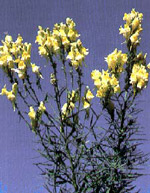Yellow toadflax
Linaria vulgaris P. Miller
Keys to Identification
- Yellow and orange snapdragon-like flowers
- Slender leaves
- Perennial
- Adventitious buds on the roots form independent plants
- Has been used as an ornamental. This weed is starting to invade pristine areas around the state
This information courtesy of the Colorado Natural Areas Program
Family
Figwort (Scrophulariaceae)
Other Names
Butter and eggs, wild snapdragon, common toadflax
USDA Code
LIVU2
Legal Status
Colorado Noxious Weed List B
Identification
Lifecycle
Perennial
Growth form
Forb
Flower
Flowers are bright yellow and resemble snapdragons. Flowers are arranged in a raceme at the ends of branches.
Seeds/Fruit
Seed capsules are round-ovate, 0.3-0.5 in long, and two-celled. Seeds are brown or black, circular, and surrounded by a notched wing.
Leaves
Leaves are narrow, lance-shaped, soft, and pale green. Leaves are mainly alternate but lower leaves appear to be opposite due to crowding.
Stems
Mature yellow toadflax plants are 1-3 ft tall with 1-25 smooth erect floral stems.
Roots
Taproots may be up to 3 ft long. horizontal roots may grow to be several yards long, and can develop adventitious buds that may form independent plants.
Seedling
No information available.
Other
Closely related to Dalmatian toadflax(Linaria dalmatica).
Similar Species
Exotics
Leaves of Dalmatian toadflax are shorter, wider, and broadbased, clasping the stem.
Natives
None known.
Impacts
Agricultural
Yellow toadflax contains a poisonous glucoside that is reported to be mildly poisonous to cattle (Morishita 1991). However, the plant is considered unpalatable and reports of livestock poisonings are rare.
Ecological
Yellow toadflax is quick to establish in open sites and is capable of adapting growth to a wide range of environmental conditions. Yellow toadflax aggressively forms colonies through adventitious buds from creeping root systems. These colonies can push out native grasses and other perennials, thereby altering and simplifying the species composition of natural communities and reducing forage production for livestock and wildlife.
Habitat and Distribution
General requirements
Yellow toadflax has a highly variable habitat that depends on environmental factors such as shading, grazing, and soil type (Saner et al. 1995).
Distribution
Yellow toadflax now occurs throughout the continental United States and in every Canadian province and territory (Saner et al. 1995). In Colorado, yellow toadflax is widespread. It is typically found from 6,000 to 8,500 feet, but can be found up to 10,000 feet.
Historical
Yellow toadflax was introduced from Eurasia as an ornamental.
Biology/Ecology
Life cycle
Spring emergence occurs around mid-April and depends primarily on temperature. A smaller flush of seedlings can occur in the fall. Prostrate stems emerge in September and produce leaves that are egg-shaped, 0.9-1.5 in. Prostrate stems are tolerant to freezing and are associated with floral stem production the following year (Robocker 1974). The strong, upright floral stems that are characteristic of mature toadflax plants develop after a winter’s dormancy, and emerge about the same time as seedlings in mid-April. Flowering occurs from May through August and seeds mature from July through October (Saner et al. 1995). Yellow toadflax is self-incompatible and relies on insects for pollination. The two most important pollinators are bumblebees and halictid bees (Zimmerman 1996).
Mode of reproduction
Yellow toadflax can reproduce both by seeds and vegetatively. Vegetative reproduction enables a stand of toadflax to spread rapidly. Stems develop from adventitious buds on primary and lateral roots. These buds can grow their own root and shoot system, and become independent plants the next year. Yellow toadflax colonies persist mostly via vegetation means while those of Dalmatian toadflax persist both by vegetative and seed reproduction (Lajeunesse 1999).
Seed production
A mature plant can produce up to 30,000 seeds annually. A single stem has been reported to contain over 5,000 seeds (Saner et al. 1995).
Seed bank
Seeds can remain dormant for up to ten years.
Dispersal
Winged seeds aid wind dispersal. Seeds may also be dispersed by water and ants (Rutledge, 1998).
Integrated Management Summary
Yellow toadflax rapidly colonizes open sites. It is most commonly found along roadsides, fences, rangelands, croplands, clear cuts, and pastures. Disturbed or cultivated ground is a prime candidate for colonization. The seedlings of yellow toadflax are considered ineffective competitors for soil moisture with established perennials and winter annuals (Morishita 1991). However, once established, yellow toadflax suppresses other vegetation mainly by intense competition for limited soil moisture. Mature plants are particularly competitive with winter annuals and shallow-rooted perennials.
References
Lajeunesse, S. 1990. Dalmatian and yellow toadflax. In: R.L. Sheley and J.K. Petroff (eds.) Biology and management of noxious rangeland weeds. Oregon State University Press, Corvallis. pg. 202-216.
McClay, A.S. 1992. Effects of Brachypterolus pulicarius (L.) (Coleoptera: Nitidulidae) on flowering and seed production of common toadflax. The Canadian Entomologist 124: 631-636.
Moroshita, D.W. 1991. Dalmatian toadflax, yellow toadflax, black henbane, and tansymustard: importance, distribution, and control. Pages 399-408 In: L.F. James, J.O. Evans, M.H. Ralphs, and R.D. Child (editors) Noxious range weeds. Westview Press, Boulder, San Francisco, and Oxford.
Robocker, W.C. 1974. Life history, ecology, and control of Dalmatian toadflax. Tech. Bull No. 79. Wash. Agric. Exp. Stn.
Rutledge, Chris R. and Dr. Terry McLendon. No Year. An Assessment of Exotic Plant Species of Rocky Mountain National Park. Department of Rangeland Ecosystem Science, Colorado State University. 97pp. Northern Prairie Wildlife Research Center
Saner, M.A., D.R. Clements, M.R. Hall, D.J. Doohan, and C.W. Crompton. 1995. The biology of Canadian weeds. 105. Linaria vulgaris Mill. Canadian Journal of Plant Science 75: 525-537.
Zimmerman, J.A.C. 1996. Ecology and distribution of Linaria vulgaris (L.) Miller, Scrophulariaceae. USGS Biological Resources Division, Colorado Plateau Field Station-Flagstaff, Arizona. Internet. 01/14/98.


